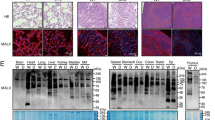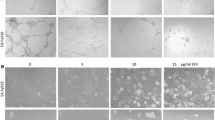Summary
Human umbilical venous endothelial cells were transformed with a temperature-sensitive mutant of simian virus 40, tsA640, and a cell line, subcultured for over 20 serial passages, was established at a temperature permissive for the virus. Treatment of transformed endothelium with 3μg/ml chloroquine caused a specific reduction of α-glactosidase activity, without cell injury, and revealed several electron-dense materials surrounded by single unit membranes. Crystalline lamellae in lysosomes with a periodicity of 6.5 nm, which are typically seen in various tissues in Fabry disease, were produced in the presence of a glycosphingolipid mixture. These cells should be useful for in vitro pathophysiological studies on Fabry endothelium.
Similar content being viewed by others
References
Chang SE (1986) In vitro transformation of human epithelial cells. Biochim Biophys Acta 823:161–194
Chou JY (1978) Establishment of clonal human placental cells synthesizing human choriogonadotropin. Proc Natl Acad Sci USA 75:1854–1858
de Groot PG, Elferink RO, Hollemans M, Strijland A, Westerveld A, Khan PM, Tager JM (1981) Inactivation by chloroquine of α-galactosidase in cultured human skin fibroblasts. Exp Cell Res 136:327–333
Desnick RJ, Bishop DF (1989) Fabry disease: α-galactosidase deficiency. In: Scriver CR, Beaudet AL, Sly WS, Valle D (eds) The metabolic basis of inherited disease, 6th edn. McGraw-Hill, New York pp 1751–1796
Desnick RJ, Doughman DJ, Riley FC, Whitley CB (1974) Fabry keratopathy: molecular pathology of the chloroquineinduced phenocopy: Am J Hum Genet 26:A26
deVeber GA, Schwarting GA, Kolodny EH, Kowall NW (1992) Fabry disease: immunocytochemical characterization of neuronal involvement. Ann Neurol 31:409–415
Estes ML, Ewing-Wilson D, Chou SM, Mitsumoto H, Hanson M, Shirey E, Ratliff NB (1987) Chloroquine neuromyotoxicity: clinical and pathologic perspective. Am J Med 82:447–455
Gimbrone MA Jr, Farred GC (1976) Transformation of cultured human vascular endothelium by SV40 DNA. Cell 9:685–693
Gonzalez-Noriega A, Grubb JH, Talkad V, Sly WS (1980) Chloroquine inhibits lysosomal enzyme pinocytosis and enhances lysosomal enzyme secretion by impairing receptor recycling. J Cell Biol 85:839–852
Hasholt L, Sorensen SA (1986) Lysosomal α-galactosidase in endothelial cell cultures established from a Fabry hemizygous and normal umbilical veins. Hum Genet 72:72–76
Hasholt L, Wandall A, Sorensen SA (1988) Enzyme replacement in Fabry endothelial cells and fibroblasts: uptake experiments and electron microscopical studies. Clin Genet 33:360–371
Hayasaka S, Noda S, Setogawa T (1988) Effect of drugs in vitro on lysosomal enzyme activities in bovine retinal pigment epithelial cells. Jpn J Ophthalmol 32:316–321
Hostetler KY, Reasor MJ, Yazaki PJ (1985) Chloroquineinduced phospholipid fatty liver: measurement of drug and lipid concentrations in rat liver lysosomes. J Biol Chem 260:215–219
Ide H, Minamishima Y, Eizuru Y, Okada M, Sakihama K, Katsuki T (1988) Transformation of human endothelial cells by SV40 virions. Microbiol Immunol 32:45–55
Jaffe EA, Nachman RL, Becker CG, Minick CR (1973) Culture of human endothelial cells derived from umbilical vein. Identification by morphologic and immunologic criteria. J Clin Invest 52:2745–2756
Johnson D, Desnick RJ (1978) Molecular pathology of Fabry's disease. Physical and kinetic properties of α-galactosidase A in cultured human endothelial cells. Biochim Biophys Acta 538:195–204
Katsumoto T, Inoue M, Naguro T, Kurimura T (1991) Association of cytoskeletons with the Golgi apparatus: threedimensional observation and computer-graphic reconstruction. J Electron Microsc (Tokyo) 40:24–28
Kimura G, Dulbecco R (1973) A temperature-sensitive mutant of simian virus 40 affecting transforming ability. Virology 25:529–534
Kimura G, Itagaki A (1975) Initiation and maintenance of cell transformation by simian virus 40: a viral genetic property. Proc Natl Acad Sci USA 72:673–677
Klinghardt GW, Fredman P, Svennerholm L (1981) Chloroquine intoxication induces ganglioside storage in nervous tissue: a chemical and histopathological study of brain, spinal cord, dorsal root ganglia, and retina in the miniature pig. J Neurochem 37:897–908
Lüllman-Rauch R (1979) Drug-induced lysosomal storage disorders. In: Dingle JJ, Jaques PT (eds) Lysosomes in biology and pathology, vol 6. North-Holland, Amsterdam, pp 49–130
Matsunaga Y, Hostetler KY (1980) Studies on drug-induced lipidosis: subcellular localization of phospholipid and cholesterol in the liver of rats treated with chloroquine of 4,4′-bis(diethylaminoethoxy) α, β-diethyldiphenylethane. J Lipid Res 21:201–214
Mito T, Ohno K, Takashima S (1989) Effects of endotoxin on cultured venous and arterial endothelial cells from human umbilical cord. Yonago Acta Med 32:163–174
Ohno K, Kimura G (1984) Genetic analysis of control of proliferation in fibroblastic cells in culture. II. Alteration in proliferative and survival phenotypes in a set of temperature-sensitive mutants of rat 3Y1 cells after infection or transformation with simian virus 40. Somat Cell Genet 10:29–36
Ohno K, Nanba E, Miyawaki S, Sakiyama T, Kitagawa T, Takeshita K (1982) A cell line derived from sphingomyelinosis mouse shows alterations in intracellular cholesterol metabolism similar to in type C Niemann-Pick disease. Cell Struct Funct 17:229–235
Reasor MJ (1989) A review of the biology and toxicologic implications of the induction of lysosomal lamellar bodies by drugs. Toxicol Appl Pharmacol 97:47–56
Schlegel-Haueter SE, Schlegel W, Chou JY (1980) Establishment of a fetal rat liver cell ine that retains differentiated liver functions. Proc Natl Acad Sci USA 77:2731–2734
Takayama H (1981) Production of interferon by an SV40transformed macrophage line, BB-W-531–2. Microbiol Immunol 25:683–692
Tanigawa T, Takayama H, Takagi A, Kimura G (1983) Cell growth and differentiation in vitro in mouse macrophages transformed by a tsA mutant of simian virus 40. I. Cellular response in proliferative and phagocytic activities to the shift of temperature differs depending on the cultures state in mouse bone marrow cells transformed by the tsA640 mutant of simian virus 40. J Cell Physiol 116:303–310
Tomè FMS, Fardeau M, Leoir G (1977) Ultrastructure of muscle and sensory nerve in Fabry's disease. Acta Neuropathol (Berl) 38:187–194
Vance DE, Krivit W, Sweely CC (1969) Concentrations of glycosyl ceramides in plasma and red cells in Fabry's disease, a glycolipid lipidosis. J Lipid Res 10:188–192
Weibel ER, Palade GE (1964) New cytoplasmic components in arterial endothelia. J Cell Biol 23:101–112
Author information
Authors and Affiliations
Additional information
Supported in part by a Grant (3A-3) for Nervous and Mental Disorders from the Ministry of Health and Welfare, Japan
Rights and permissions
About this article
Cite this article
Inagaki, M., Katsumoto, T., Nanba, E. et al. Lysosomal glycosphingolipid storage in chloroquine-induced α-galactosidase-deficient human endothelial cells with transformation by simian virus 40: in vitro model of Fabry disease. Acta Neuropathol 85, 272–279 (1993). https://doi.org/10.1007/BF00227722
Received:
Revised:
Accepted:
Issue Date:
DOI: https://doi.org/10.1007/BF00227722




